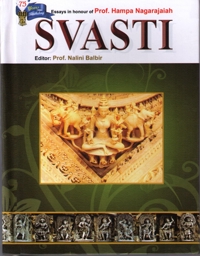27
Mahāprajña’s Contribution to Anekānta Philosophy
Its Real-Time ApplicationsIntroduction
One question - what is the solution to the problems and miseries of mankind - is bothering all of us alike. Is the answer political, philosophical, mathematical, social, religious or divine? The answer cannot be political alone, because of vested interests. It cannot be philosophical only, as it has to deal with ground realities. It cannot be social, religious or divine - all riddled with controversies. It is neither capitalism - as it creates divide between haves and have-nots, nor could it be philanthropic or communistic - as such experiments have already failed. Science and mathematics cannot answer as the human behavior does not follow any formula. What if there is a ray of hope which is all inclusive?
Most of the religions and philosophies in this world have made efforts and taken interest in the creation of peace and happiness needed by all of us. India has a long, rich and diverse tradition of philosophical thought spanning some two and a half millennia through which an attempt was made to understand the true nature of Reality. It is believed that once the truth is understood, the chaos and conflict between man and man will stop.
Fortunately, Jain philosophy has enriched the freedom of human thought by its doctrine of Anekānta. We are very well familiar with the Jain philosophical terms Anekāntavada, Syādvāda, Nayavāda, Nikṣepa, Tribhaṅgi, Caturbhaṅgi, Saptabhaṅgi and four Anuyogas. All of these methodologies are interrelated and have contributed in explaining the Reality or Truth with a strong tradition of rationality. Further they promote a multi-faceted approach to the problem of the knowledge of Reality. It is of special interest that out of these methodologies, Anekānta became popular to an extent of doctrine and the rest of the methodologies gradually fell into oblivion.
Anekānta, as a doctrine, has the reasoning of science - logic of mathematics, compassion of religion and equality of humans - at its centre. The hallmark of this thought process is the understanding of wholeness along with multidimensionality of Truth.
Hermann Jacobi[1] the German Indologist has pointed out that Anekānta opens the floodgates to the comprehension of Reality not only in toto but also in its different aspects.
Another German Indologist Professor Alsdorf[2] has said “there is no exaggeration if it is said that most of the original Jain contribution to Indian scholarship was made in the field of methodology”.
The Indian Jainologist Dr. A.N. Upadhye[3] said: “The approach to Reality adopted by Anekāntavāda strikes an original note in the history of Indian logic.”
Anekāntavāda
Unique to Jain philosophy is its concept of Anekānta. Anekānta simply means viewing the Reality or Truth in its diverse aspects. Anekānta describes that each object of knowledge is found with infinite attributes, modes or paryayas so the knowledge of the true nature of every object should be viewed from different angles, i.e., the truth can be known through numerous paths like all the radii of a circle confluence at its center. Truth is one, singular and unique but there can be more than one way to reach it. An observation of an object at a particular spatial-temporal instant is just one facet of the truth. Thinkers having a singular view in mind can see only one facet of Reality and cannot realize Reality in full. A famous anecdote in which ten blind men touching different parts of an elephant come up with different observations explains Anekānta in right perspective. Only a person with vision can tell the Truth - a whole elephant.
An example is Sthānāṅga Sūtra, where the jīva (soul) is defined in several alternative ways elaborates this:
- It is singular to each animated being.
- It could have two types: bonded with karmas or liberated.
- It has three properties: origination, transformation and perpetuity.
Likewise, there could be ten different ways to look at it. So the attitude of Anekānta can mitigate several confrontations among different sects, societies, states and nations. Therefore, it exhibits tolerance to other faiths to the extent that whosoever follows the path of Anekānta finds peace and happiness and in doing so contributes to the well-being of all life in the world.
Anekānta is not simply a multisided perception theory but it is remarkable to find that some of the attributes appear to be mutually contradictory or opposite and they do co-exist in the same object. The leading Jain Ācārya Mahāprajña has successfully professed this view-point of Anekānta and discussed its applications in day-to-day life. Swami Vivekananda is a good example of the ‘Gitian soul’. Likewise Mahāprajña’s contributions in the field of Anekānta are tremendous and we will discuss only his viewpoints here in the context of the Principle of Coexistence of Opposites.
Principle of Coexistence of opposites
Mahāprajña has successfully professed the Anekānta viewpoint of Jainism. He pronounces that the whole is the sum total of two opposites. This is an amazing statement on the part of Mahāprajña, as he explains that opposites do not cancel each other, on the contrary they are complementary and add up to make a whole. A student of science knows thoroughly well that if there is matter, anti-matter is equally abundant. Opposites are actually two faces of the same coin, whose true and clear picture is complete only when both faces coexist together at the same place and the sea point of time. For ease of understanding such pairs the author prefers to term them as “Copposites”.
Definition of “Copposites”
Mahāprajña has stipulated a few postulates in order to expand this ‘theory of opposites’:
Examples from Jain Literature
The term “pudgala’ is extensively used in Jain literature to describe the constitution of matter. Today, scientists use similar terminology for quarks and other micro-particles. They have assigned various basic properties to these particles like frequency, spin, etc. Identical references are available in Jain literature regarding the basic tenets of a ‘pudgala’, which are varṇa (colour), gandha (smell), rasa (taste) and sparśa (touch).[4] The last quality of pudgalas, namely sparśa has a further classification consisting of four opposite pairs: snigdha-rūkṣa (Degrees of smoothness, laghu-guru; Light-Heavy (measurement of weight), śīta-uṣṇa (Degreees of temperature) and mr̥du-karkaśa (readiness to interact). In any composition of matter, presence of these opposite pairs is essential. The entire universe is based on the co-existence of opposites.
The law of opposites as propounded by Mahāprajña has its roots in the Jain Āgamas: Sthānāṅga, Nandi, and Daśavaikālika have the description of opposite couplets aplenty. Some of them are mentioned forthwith:
1.
Mentions of pairing opposites are abundant in the first and second sections of the Sthānāṅga Sūtras. Sixteen axioms are stated in the opening paragraph of the first chapter. Out of these fifth to fourteenth are of special interest in the context of present discussions. These self sufficient truths are tabulated as follows:
5th There is one Loka (Universe) - 6th There is one Aloka (Void)
7th There is one Dharmāstikāya (Dynon) - 8th There is one Adharmāstikāya
9th There is one Bandha (Bondage) - 10th There is one Mokṣa (Emancipation)
11th There is one Puṇya (Chastity) - 12th There is one Pāpa (Sin)
13th There is one Āsrava (Attraction) - 14th There is one Saṃvara (Repulsion)[5]Mahāprajña comments that these axioms actually form pairs. The universe is fully filled with opposing pairs, or we may say that it is because of opposing pairs that the universe exists.
2.
The heading of the first paragraph of the second chapter of the Sthānāṅga Sūtra is ‘Dvipadāvatāra’ - meaning duo.[6] It says that everything under the sun appears in pair. A few such examples are: jīva-ajīva, trasa-sthāvara, dharma-adharma, vedanā-nirjarā etc.
3.
Similar pairs are mentioned in the Nandi-Sūtra. Seven pairs of śruta are described therein.
4.
In the Daśavaikālika Sūtra, four key human emotions - Anger, Ego, Affection and Greed are prominently discussed. The Sūtra states that these emotions coexist with the contrasting feelings. Anger can be diluted by forgiveness and Ego with humility. Affection too is a kind of bondage and can be countered by equanimity. Greed can be overcome by the feeling of contentment. The entire gist of these discussions is that the opposites coexist.
Mahāprajña says that the Jains do not see things in black and white only. Their vision is not restricted to true-false but the third dimension of relative-truth is added to it. All thoughts and alternatives are just the diagonals of circle - all equal and identical.
Duality
Understanding of Anekānta is incomplete until we discuss the duality of all the ‘reals’. Mahāprajña has observed the duality of apparently contrary attributes in a substance and found that they enjoy mutual concomitance. Some of them are as follows.
- Universal and Particular
- Permanent and Impermanent
- Existence and Non-existence
- Speakable and Unspeakable
According to this principle no substance in this world is forever permanent or impermanent. Every substance has an intrinsic harmony between the permanence and transience. The existence of ‘reality’ is eternal, so it is permanent. But, ‘reality’ undergoes transformations shape, association, time, etc. - so it is impermanent also. Transition means the creation of ‘new’, cessation of ‘old’ and continuation of ‘pure’. It is, therefore, evident that every substance is the integration of three characteristics, namely, origination, destruction and the eternity.
Applications
Mahāprajña has established the practical utility of the above principle which can be put to good use in resolving our every day conflicts of life. We shall present his thoughts concisely.
Democracy
Opposition is the backbone of any democratic setup. Leftists keep rightists under reign. Now-a-days, however, the opposition is more to pull down the ruling party, rather than for strengthening it. A supporting and balancing role of opposition will create a healthy environment for the entire country. The basis of democracy is very much similar to that of Jain spiritualism, which stresses on the simultaneous presence of dharmāsti- and adharmāsti-kāya. It is also similar to the practical life where accumulation and renunciation of wealth, both are equally important and necessary. It is why, of all forms of governance, democracy is considered the most effective and stable way, because it is based on the complementing structure of two opposites.
Destiny and Decisions
Modern society by and large follows two diagonally opposite doctrines. One section believes “Decisions and actions make destiny”, while the other section believes “Whatever happens is predestined.” Here, Mahāprajña urges us to apply the law of opposites. The moment we accept the coexistence of positive-negative pair, the whole conflict collapses. It is a matter of common experience that howsoever hard one works, the results may not be commensurate with the efforts. Contrarily, if one sits idle and waits for destiny to act, void is what results! Decisions carve destiny and destiny moulds decisions.
Individual Society
It is aptly said that a man is a social animal. At times, the interests and preferences of an individual may conflict with those of the society, yet can the two be separated? Can the droplet survive beyond the ocean? Isn’t the ocean made of droplets? But ships cannot float on droplets and the ocean cannot be carried in a container. An individual is as good as the society he lives in and vice-versa. An individual cannot take and sustain his growth in isolation. We have a case of reservations as example.
In India, a section of society grew allegedly at the cost of another. This called for the concept of reservation, as the decision makers were aware of the fact that the whole family of Indians must grow and become strong in order to survive globally. This resulted in conflict and friction. What if we see the whole situation differently from the view point of the theory of opposites? We find a very simple answer to this vexed issue: if an individual, who receives the benefits of reservation, is ready to pay back to the society in the form of a simple promise - that his dependents and all the future generations will not further burden the society with perpetual benefits of reservation. This way, both the short-term and the long-term interests of an individual and the society can be met.
Mahāprajña says that the cooperation and coordination is obvious in all the activities of the universe. Creation-destruction, life-death, ephemeral-immortal, light-dark; they all coexist, yet our minds have created the concept of conflict, which must be transformed to the theory of harmonizing and complementing the opposites.
Science and Spiritualism
Science is objective - always looking for cause and effect relationship. Philosophy is subjective - based on intangible experiences. As a pair, they become a fit case for applying the ‘theory of complementing opposites.’ Surprisingly. Most scientific discoveries have philosophical origins. Similarly, science is giving new dimensions to the spiritual awakening. They need to be mutually reinforced further, rather than one discarding another. Today, science has concluded that if there is matter, there exists anti-matter too. They extrapolated the concept from atom/anti-atom, practical/anti-practical to universe/anti-universe. How similar it sounds to the concept of Dharmāstikāya-Adharmāstikāya and Loka-Aloka described in Jain literature!
Examples from Rishabhayana
Rishabhayana is one of the many verses penned down by Mahāprajña. Sādhvī Śrutayaśā has searched several instances, which sound paradoxical at first, but contain the deep-rooted message of coexistence of opposites. A few such mentions are:
All these are imaginations of a poet, yet are very close to the truth. Mahāprajña has extended his imagination up to the horizon where the practical reality meets the scientific theory. His logic is very simple: meet. According to him, the principle of Anekānta gives us a tool with which the seemingly opposite ends can be bent to encircle the complete picture, which depicts the complete truth.
Examples from Medical Science
Einstein has stated that the music cannot be truthfully described in scientific terms of frequencies and amplitudes only. It has an intrinsic value, above and beyond science, entering into the arena of higher consciousness. Human body is just like a symphony. It can be quantified in terms of medical parameters of blood, bones and muscles, yet it has an intangible and impenetrable spirit. A complete picture emerges only when ‘the obvious’ meets ‘the occult’. Mahāprajña has cited several examples from human anatomy where the two diagonally opposite forces exist and act in a coordinated manner.
Examples from physics
Scientific investigations of the micro-world have so far revealed that the basic building blocks of the matter are quarks. Interestingly, these quarks are found in pairs of opposite spins. Even before this discovery, the coexistence of electron and proton, positivity and negatively charged particles is a well-established scientific fact. When Einstein described the properties of light, a startling fact was discovered that the light has the dual nature of behaving as a particle and as a wave. Science coud progress this far only after accepting the dualism of light. Properties of light have become central to the entire physics.
We very well know properties of a magnet. Both north and south poles constitute a magnet. Even when broken into pieces, each piece keeps on exhibiting both poles in its magnetic force. Whatever we do, the two poles cannot be separated just as we cannot separate Siamese twins. If by some means, we are able to demagnetize a magnet, both poles disappear together. A magnet with single pole is impossibility.
Another excellent example from the field of physics is that of friction. One might think of an easy motion in the absence of friction, but the matter of fact is that the motion would not have been possible had there been no friction.
Conclusion
Life and universe are nothing but a delicate balance of opposing forces, conflicting particles, contrasting energies and divergent view points. No adjective, no verb exists in this entire world, which does not have an antonym. Without the pairing opposite the word will loose its meaning. Light will be rendered redundant in the absence of darkness.
It is in our hands to convert conflict into complement. This is the main teaching of Jainism. Freedom should be responsibly controlled. Mankind must realize that male-female, hot-cold, light-dark, ephemeral-immortal, etc. All are inevitable reality. When they form the basis of our existence, we too, must live in harmony and compromise rather than conflict.
Further reading
- Acharya Mahaprajna, The Quest for Truth, Jain Vishva Bharati University, 2003.
- M. R. Gelra, Science in Jainism, Jain Vishva Bharati University, Ladnun, 2002.
M.R. Gelra, “Anekānta - A Jain contribution to scholastic methodology”, in Science in Jainism, pp. 11-22.
See Gaṇādhipati Tulsi, Jaina-Siddhānta-Dīpikā, chapter I. English translation by Late Dr. Satkari Mookerjee, Anekānta Śodha-Pīṭha, Jain Vishva Bharati, Ladnun, 1995.
 Dr. Mahavir Raj Gelra
Dr. Mahavir Raj Gelra

